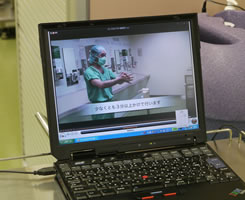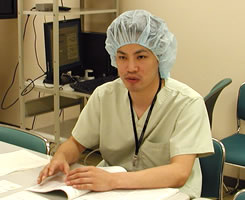- Home
- Healthcare Case Study
- The Introduction of the Rubbing Method through a Multilateral Approach
The Introduction of the Rubbing Method through a Multilateral Approach

Gifu University Hospital
-
Address:1-1 Yanagido, Gifu City, Gifu, Japan
-
Number of beds:606
-
Total number of staff:1,170 (as of September, 2011)
-
Number of surgeries:4,868 (April 2010 to March 2011)
-
Website:https://www.hosp.gifu-u.ac.jp/eng/
※Saraya Co., Ltd.'s privacy policy does not apply to the linked website.
Please refer to the privacy policy posted on the site.


Alcohol-based hand rub
Steps taken to introduce the rubbing method
- What is the background that led you to consider the introduction of the rubbing method?
In 2006, a member of the infection control team (ICT) from our operation department performed some research and suggested the introduction of the rubbing method and its benefits. We then explained the pros and cons of the rubbing method to our staff at a monthly conference, and following the explanation, we provided the opportunity for all staff members to experience the rubbing method. Through these activities, we gained their understanding and began to introduce the rubbing method with procedure panels placed at the hand preparation area.
There was an exception made for staff members who were sensitive to alcohol, and they could continue to use the scrubbing method, but all other nurses needed to adopt the rubbing method. As for the doctors, we were able to gain a consensus for all but two departments, and we then distributed the instruction videos. However, we did not force the doctors to use the rubbing method and left it to their choice, which resulted in a lower transition rate to the rubbing method.
- What was the turning point that led you to require the rubbing method for the entire staff and for all departments?
|
Ms. Murase, chief nurse of the operation department |
In 2009, multiple incidents of surgical site infection (SSI) were reported. To address this situation, we received a hospital round from the National University Hospitals Infection Control Council. After this hospital round, they indicated that there were some staff members who had not performed the surgical hand hygiene properly due to the confusion caused by the use of two methods. This led us to consider standardizing the use of the rubbing method. |
||
- Did the introduction of the rubbing method to the doctors go smoothly?
After the SSI incidents and the feedback from the National University Hospitals Infection Control Council, the ICT and operation department considered the necessary measures and decided to require the rubbing method for all staff members. We then gained approval from the governing board of the operation department, which includes the heads of the ward physicians of the central clinical departments and the other clinical departments. In addition, we held a lecture by the infection control nurse on SSI and surgical hand preparation that was given at the hospital's biannual medical safety/infection control seminar. We explained the benefits of standardizing the rubbing method and provided training for the surgical hand preparation procedure. These activities enabled us to disseminate information about the rubbing method among all members of the staff, including the doctors, and thus contributed to a smooth transition.
- How did you manage the members of the staff sensitive to alcohol?
We secured a sink for the use of the scrubbing method for the staff members who were sensitive to alcohol and trained them so that they could perform the appropriate surgical hand preparation. As a disinfecting product, we provided both chlorhexidine gluconate and povidone iodine types so that they could choose.
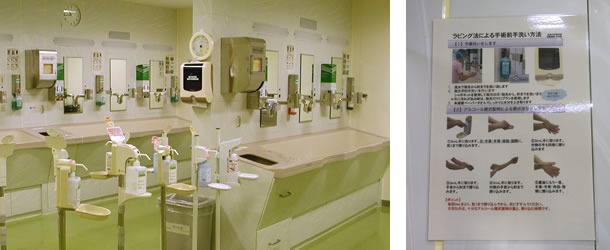
Hand preparation area of the operating theatre.
Prepared environment with a clean sink, rubbing method procedure panel mounted on the wall, and alcohol-based hand rub.
After introducing the rubbing method in all departments
- How did you manage to familiarize the method to the entire staff?
|
The DVD that has been played repeatedly at the hand preparation area of the operating theatre. The staff can check the appropriate procedure at any time, and it also acts as a reminder for the staff. |
We made a hospital-wide decision to standardize the rubbing method and informed the staff through lectures during a hospital seminar that was targeted to the entire staff. We also made procedure panels, posters, and DVDs for training and distributed them to each department. However, one month after the introduction, the penetration rate was not as expected. Therefore, we installed a laptop at the hand preparation area in the operating theatre to play the DVD explaining the rubbing method procedure so that it could be reviewed at the site. In addition, since there was a nurse leader helping the doctor don the surgical gown at the site, we decided to have the nurse also check if the doctor used the rubbing method and if the procedure and volume of alcohol-based hand rub used were appropriate. Our target was to have 80% of the doctors use the rubbing method, and thanks to our hospital-wide action to reduce SSI, the doctors also became cooperative, which led us to achieve our initial target of 80% among doctors and 100% among nurses after three months. |
||
- Why did you select a DVD as the tool?
At a meeting, the ICT and operation department discussed how to involve the entire staff and disseminate the method, including to doctors and students, who frequently change. Among the different ideas, we decided to utilize a DVD as a tool because it could provide a visualization of the procedure and thus be easily understood, and DVDs are also easy to distribute.
When making the DVD, standardization and optimization were emphasized. By standardization, we meant depicting a clearly adequate and universally implementable procedure. By optimization, we meant creating a DVD that was easily understood and utilized in consideration of the characteristics of an operation department at a university hospital, where staff members and students change frequently, so that all viewers could easily use the rubbing method.
We created the DVD internally. Modelling the procedure was our instructor at the operation department, and it was shot and edited by the deputy director. We created the DVD using staff members who we all work with every day so that everyone in the operation department, including the surgeons, nurses, residents, and students, could view the DVD and follow the rubbing method fully.
- What was the outcome of playing the DVD repeatedly at the hand preparation area in the operation department?
Posters only use photos and explanations, so the method, procedure, or the time needed can be unclear. A DVD shows the exact procedure at its actual speed, so following the DVD will enable the appropriate hand preparation procedure. There are many staff members who practice surgical hand hygiene, and many doctors and students rotate. We have found that this DVD supplements the areas where oral communication may be insufficient. This DVD has been made available to public on YouTube so that it can be used for medical school education.
→ Jump to the YouTube video "Surgical Hand Preparation Using the Rubbing Method"
- Were there any changes made after implementing the rubbing method?
SSIs, which were what initially pushed us toward implementing the rubbing method for all departments, have not occurred since. We have not calculated the cost in detail yet, but the soap is not antibacterial and the paper towels were changed to non-sterile ones, so I believe cost per hand hygiene procedure is lower.
We had a member of the staff actually demonstrate the rubbing method for us.
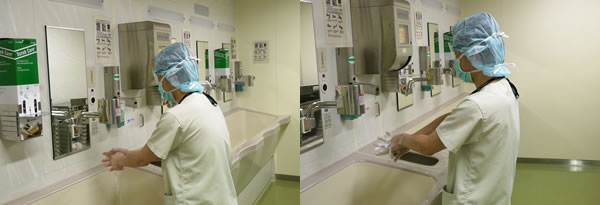
Pre-wash
Take an appropriate amount of plain soap, wash from fingertips to elbows, and rinse with running water.
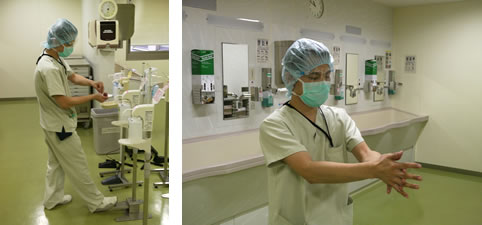
Hand rub
Take an appropriate amount of alcohol-based hand rub, add as necessary, and rub until the alcohol dries.
- Did you implement other SSI prevention measures apart from the rubbing method?
|
Mr. Kakimi, nurse |
Standardizing our surgical hand preparation procedure to the rubbing method was our major countermeasure, but we also requested an ICT round of the operating theatre and changed several items that were discovered there. For example, ensuring that nothing was placed in front of an air vent, minimizing the opening and closing of the theatre doors, and changing gloves regularly, once every three hours. Some doctors did show a concern about changing gloves as they felt it might break the shield and spoil the antiseptic conditions, but we were able to gain their understanding after showing them the scientific basis for the risks of keeping gloves on for a long period of time (an increase in resident bacteria) and the benefits of changing gloves. |
||
Doctors and nurses both shared the same goal for reducing the incidence of SSI, and so they held a discussion and created standards for individual cases when gloves are to be changed in addition to the regular changes, such as after touching bone during surgery, before inserting implants, and after any unclean operation.
Next Step
- What is your next step?
We feel that maintaining and improving the utilization and compliance of the rubbing method while completely rolling it out to all job levels is essential.
Also, we have not yet been able to evaluate the effects of transitioning to the rubbing method fully, so we would like to collect scientific evidence by gathering bacteriological data and by making a cost analysis.
In addition to the rubbing method, we must also continue to maintain a clean environment and thoroughly practice hand hygiene when assisting patients, after removing gloves, and at other appropriate occasions.
Interviewees

Ms. Taeko Murase
Background
- 1989: Began working in the operation department of Gifu University Hospital
- 1998: Began working on the surgery ward
- 2006: Became chief training nurse
- 2009: Became chief nurse of the operation department

Mr. Katsunori Kakimi
Background
- 2002: Began working in the operation department of Gifu University Hospital
- 2009: Became a member of the nursing department infection control committee.
Editor's Notes
Improving the sanitation, the environment, and health of the world.
Social

© Copyright Saraya.Co.Ltd 2024 All rights reserved.

